A beautiful habit tracker bullet journal style can take hours to create. Use our free bullet journal app to create personalized habit trackers in 2 minutes.
![]()
Habit trackers bullet journal style are very popular and you can see some beautiful motivating spreads on the internet. The problem is that some of them take hours to create, assuming you can even draw. With our free BuJo app you can create a printable habit tracker bullet journal within minutes and totally customize it to your needs.
What is a Bullet Journal Habit Tracker
A habit tracker helps you track habits that you are trying to adopt or behavior that you are trying to change. It helps you set personal goals that you aim to reach by visually showing your progress. It motivates you and keeps you accountable.
A habit tracker is not one of the core collections (spreads) in a bullet journal but it is referred to as a Custom Collection. This is a spread that a user adds to a bullet journal to serve a specific purpose, in this case, to build a new habit or change a behavior. When tracking habits, Ryder Carroll, creator of the Bullet Journal Method, suggests that you only track up to 3 habits at one time. If you track more than 3 you will become overwhelmed and probably not land up changing any of them. However, as always, do what works for you.
Bullet Journal Tracker Ideas
The following BuJo habit tracker templates can be created with our free online bullet journal app. Each template can be customized before you print. You can add doodles, text, frames, quotes or elements with a click of your mouse.
Daily Habit Tracker
There are 30 boxes for each habit but you can add more if you want. To change the habit tracker template go to “Planner Inserts” and select “Habit Trackers”. There are many options available.
You can change the images according to the habits you track. These are only examples.
Weekly Habit Tracker
There are two versions of the weekly tracker depending on whether you prefer to start your week on a Sunday or a Monday. If you added the wrong version you can delete it by clicking on the trash can in the bottom left corner. To make the bee design, either use the ready-made templates or the doodles in the “bee” category.
Monthly Habit Tracker
There are a few monthly tracker templates available. They have 28, 30, or 31 days. You can use any version. If you only want to print one version, I suggest you use the one with 31 days which can be used any month.
There are many templates available such as the circle tracker below.
The bee template has 31 honeycomb hexagons to track a habit for 31 days. If you want to delete any of the days, delete the hexagons on the top. The top 5 can be deleted. You can create a habit template for 28, 29, 30, or 31 days.
Yearly Tracker
You don’t need to start your yearly tracker in January. Start any month and complete the year.
These habit charts track a single habit over a one-year period. You can start any month and complete a year.
This is a year-at-a-glance habit tracker. You can add doodles or embellishments if you want to. You can either fill in the habit by hand after you print or click on “Add Text” and type it before you print. You can track a new habit each month or the same habit each month. Whatever works for you!
Long Term Trackers
The weekly or monthly trackers above are good for accountability since you see the days you did something and the days you didn’t.
However, the more times you repeat a behavior the better chance you have of forming a habit. Therefore, some trackers have multiple sections that you color when you do something. Since it takes at least 66 days to form a habit (see below) these trackers last longer and have a better success rate than the shorter-term weekly or monthly trackers.
There are two ways to use this tracker. Either you can color a puzzle piece each time you do something or you can color code it. One color will be for when you do something, another for when you don’t and you might even want to include a third color for partial implementation.
If you have any more habit tracker ideas that you would like us to create for you then please leave a comment below.
Enhancing Your Habit Tracker with Color Coding
Incorporating color coding into your habit tracker can transform it from a simple tracking tool into a powerful visual diary of your personal habits and achievements. This method not only adds an element of fun and creativity to your habit tracking but also enhances your ability to quickly assess your progress and stay motivated.
The Power of Color in Habit Tracking
Color coding in habit tracking is not just about making your tracker look vibrant; it’s a practical tool for motivation, organization, and reflection. By assigning specific colors to different habits or progress levels, you can create a visually intuitive and engaging way to monitor your personal growth journey.
Setting Up Your Color Code
- Choose Your Colors: Select a palette of colors that you find appealing and motivating. You might choose colors based on personal preference, or you might assign colors based on the nature of the habit (e.g., calming colors like blue or green for relaxation habits, energetic colors like red or orange for fitness-related habits).
- Assign Colors to Habits: If you’re tracking multiple habits, assign a different color to each habit. This will help you quickly identify which habit you’re looking at in your tracker.
- Create a Legend: Include a legend in your bullet journal that explains what each color represents. This is especially helpful if you’re using different colors to represent different levels of progress or completion.
Here are some suggested colors:
- Exercise/Fitness: Red or Orange – These are energetic colors that can represent physical activity and vigor.
- Healthy Eating/Nutrition: Green – Green often symbolizes health and wellness, making it a great choice for tracking healthy eating habits.
- Hydration/Water Intake: Blue – Blue is reminiscent of water, making it a natural choice for tracking hydration.
- Meditation/Relaxation: Light Blue or Lavender – Soothing colors like light blue or lavender can represent calmness and relaxation.
- Sleep/Rest: Dark Blue or Navy – Darker shades of blue can symbolize night and rest, suitable for tracking sleep.
- Reading/Learning: Purple – Purple is often associated with wisdom and creativity, making it a good choice for tracking reading or learning activities.
- Personal Projects/Creative Work: Yellow or Gold – Bright and inspiring, yellow or gold can represent creativity and personal projects.
- Socializing/Relationships: Pink – Pink, often associated with care and friendship, can be used for tracking social activities and time spent nurturing relationships.
- Work/Productivity: Grey or Black – Neutral colors like grey or black can represent work and professional tasks, distinguishing them from more personal activities.
- Financial Goals/Saving: Gold or Green – Gold can symbolize wealth and savings, while green is also a color often associated with money and financial goals.
Remember, these are just suggestions, and the most important aspect is choosing colors that resonate with you personally. The effectiveness of a habit tracker is greatly enhanced when it is tailored to your preferences and lifestyle.
Using Color Coding in Your Habit Tracker
- Daily Tracking: For each day that you successfully practice a habit, color in the corresponding section of your tracker with the color assigned to that habit. If your tracker is divided into segments or boxes for each day, fill in the appropriate segment.
- Progress Levels: You can also use color coding to represent different levels of achievement for a habit. For example, light green could mean partially completed, while dark green could indicate full completion.
- Visual Motivation: As your tracker fills with color, it becomes a visual representation of your commitment and progress. This can be incredibly motivating and satisfying, encouraging you to keep up with your habits.
Tips for Effective Color Coding
- Consistency Matters: Use the same color consistently for each habit. This consistency makes your tracker easier to read and understand at a glance.
- Adjust as Needed: Feel free to change your color coding system if you find that it’s not working for you. The goal is to find a system that motivates and works best for your personal tracking style.
- Reflect and Adapt: Regularly take time to reflect on your habit tracker. Look for color patterns that indicate your most and least consistent habits, and use these insights to adapt your strategies for habit formation.
How long does it take to form a new habit?
A long time ago, I saw an ad for a popular weight loss group claiming to help form a new habit in 21 days. I joined the group and started developing new habits. On the 23rd day, I broke my diet. I tried a few more diets over the years and realized that I usually break the diet just after 21 days. It clearly doesn’t take 21 days to build a habit. Nevertheless, it is a popular claim that you can form a new habit in 21 days. It turns out that the 21-day claim was taken out of context. In the 1950s, a plastic surgeon by the name of Maxwell Maltz noticed that it would take about 21 days for his patients to get used to the surgery that he performed. He then came to the conclusion that “it required a minimum of about 21 days for an old mental image to dissolve and a new one to jell”. This quote was published in a book that sold 30 million copies. Many people quoted him and in time “forgot” that it takes a minimum of 21 days to form a habit and not 21 days.
Phillippa Lally, a psychology researcher, published a study, that determined that on average, it takes 66 days for a new behavior to become a habit. This is only an average, but from my experience, it makes more sense than 21 days.
Assuming it takes at least 66 days for a new behavior to become a habit, the most effective habit trackers will have at least 66 sections to mark. The puzzles and mandala trackers above are perfect as they have at least 66 sections each.
If a habit is not formed by the time your tracker is complete then print another one and keep going. Please note that you do not have to do it in 66 consecutive days. If you forget to perform the behavior a few times during the period, then carry on until you do it without even thinking about it. It is a process, and it takes time. It probably took you a while to form a bad habit, so don’t expect to create a new habit overnight.
How to Make a Printable BuJo Habit Tracker?
Click on the button above.
Either select a ready-made template or a blank template.
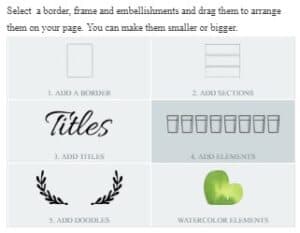
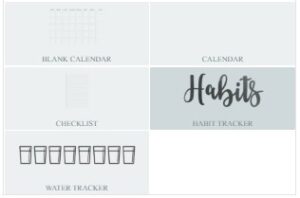
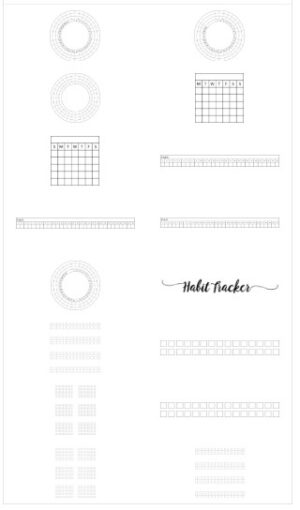
Edit the text.
Add more text.
Add doodles, titles, embellishments, banners, etc.
Download in PDF format and then print.
Habit Calendar
These cute calendar stickers can be used for multiple purposes. Use them as binder tabs, calendar stickers, habit trackers, etc. Please note that the color and the size of the calendars can be changed. You can also just use them to save you from writing a calendar in your bullet journal.
Habits to Track
Here are some ideas for bullet journal habits to track.
Health
- Increase water intake
- No soda (only water)
- Limit caffeine or coffee intake
- Limit alcohol intake
- Sleep more
- Exercise 30 minutes daily
- 10,000 steps a day
- Eat more vegetables
- Eat 5 a day (fruit and veg)
- Take vitamins
- Eat clean
- Floss daily
- No sugar
- Record period
- Eat breakfast
- Spend 10 minutes outside (for natural light)
- Meal plan
- No smoking
- No junk food
Financial
- Limit spending
- Increase savings
- Cook more and eat out/order in less
Personal Development
- Track mood (see mood tracker)
- Meditate
- Deep breathing
- Yoga
- Stretch
- Limit screen time
- Positive Affirmations
- Gratitude log
- Visualize goals
- Journal every day
- Self-reflection
- Creative activity
- Start a new hobby
- Enjoy a hobby
- Practice an instrument
- Read a book
- Volunteer
Self-Care
- Haircare
- Skincare
- Remove makeup
- Moisturize
- Relax
- Bubble bath
- Track medication (see medication log)
Organization
- Make your bed
- Keep your home tidy
- Organize an area of your home/life each day
- Limit time on social media
- Answer emails
- Pay bills on time (see bill tracker)
- Water plants
- Track chores (see chore chart)
- Take care of a pet
- Daily tasks (such as doing the dishes each day and not letting them pile up)
Relationships
- Connect with people
- Spend time with each child
- Spend time with your partner
- Communicate with partner
- Random acts of kindness
- Compliment someone
Why is a Bullet Journal Tracker Effective?
Accountability
Keeping a journal will hold you accountable. You are recording your progress and it won’t go unnoticed. Marking that you did something gives you a sense of satisfaction. This motivates some people to do more than they might have done if they were not tracking their progress.
Understand why you are not forming a habit
A habit tracker journal can be used for more than accountability. You can also record WHY you didn’t progress as planned. That will help you understand what is holding you back. For example, if you planned to exercise one day but then didn’t do it, spend a minute or two journaling about why you didn’t. You might find a way to better ensure success the next time. If you write that you were too tired, the next time you plan to work out, you might move the workout to the morning.
Tips to help you form a new habit
- Print a habit tracker and write down the habits that you want to establish. Trying to change too many new habits at once can be a bit overwhelming. There is enough space to include up to 10 new habits. If they are too complicated, then it might be too much to cope with at once.
- When trying to form a habit to do something, the best way to succeed is by doing that as many times as required until it becomes automatic — for example, drinking ten glasses of water each day. Eventually, you will find yourself drinking the water without thinking about it or counting glasses.
- When trying to stop doing something, it often helps to substitute your old bad habit with a new healthy habit. For example, if you want to stop eating dessert after a meal, start eating fruit after each meal. If you want to stop eating anything sweet after a meal you can start a new unrelated habit like brushing your teeth or rinsing your mouth after a meal. I personally recently stopped eating fruit after lunch, which had become a habit, and I started putting hand cream on my hands after lunch. It is unrelated, but my hands feel soft, and it helped me substitute a bad habit with a new habit. It made my hands softer and eventually stopped me from automatically thinking about fruit or something sweet after a meal.
- You don’t just develop bad habits out of the blue. Bad habits are developed via a process called the behavior chain. This is a subconscious process that controls your actions even if you are not aware of the process. The first step you will need to take to form a new habit is to understand the process. All processes start with a trigger. The trigger can be related to a feeling, a smell, an action, an event, etc. The trigger produces thoughts such as “I need ice cream” and these thoughts lead to actions (eating ice cream). If you are finding it hard to change a habit, spend some time trying to understand your specific behavior chain. On the days when you don’t do the habit you planned to do, keep a record of the trigger, thought, and action that lead to you skipping the new habit or doing something you didn’t want to do.
- Use a habit contract for accountability.
- Use the Mel Robbins 5 Second Rule before you start thinking of excuses not to do your habit. The very moment you start to hesitate before doing your habit, use the 5 Second Rule. When you feel yourself hesitate before doing something that you know you should do, count 5-4-3-2-1, and when you reach 1 move towards action. There is a window that exists between the moment you have the instinct to do your new habit and your mind persuading you not to. According to Mel Robbins, it’s a 5-second window and it exists for everyone. The 5 Second Rule can prevent your mind from working against you when you are developing new habits. You can start the momentum before the excuses enter your mind.
- One of the best ways to develop good habits is to start working on them as soon as possible. If you have kids, help them develop good healthy habits when they are young. They can even use a habit tracker to track their homework if they are not in the habit of doing homework every day (see our free homework planner which might also help with this).
- One way to make you more accountable is to get the entire family on board. Let each family member choose one habit they want to work on and print a habit log for each person. See the list of habit tracker ideas above. Getting my kids to join me helps me a lot. I want to set a good example for them so it motivates me.
Habit Quotes
If you need some motivation to stick to your new habits, why not add a motivational habit quote to your tracker? Here are some you might like. You can either type a quote or add one from the quote category.
Good habits are worth being fanatical about. John Irving
Discipline is choosing between what you want now and what you want most. Abraham Lincoln
You shouldn’t be challenging yourself to change a habit for just a short period of time. The point of habits is to change behavior over the long term. Richard D. Rawlings
Successful people aren’t born that way. They become successful by establishing the habit of doing things unsuccessful people don’t like to do. William Makepeace Thackeray
Excellence is an art won by training and habituation. Aristotle
Change might not be fast and it isn’t always easy. But with time and effort, almost any habit can be reshaped. Charles Duhigg
You’ll never change your life until you change something you do daily. The secret of your success is found in your daily routine. John C. Maxwell
Good habits are worth being fanatical about. John Irving
Drop by drop is the water pot filled. Buddha
Watch your habits they determine your character. Winston Churchill
We become what we repeatedly do. Sean Covey
Conquer your bad habits or they will conquer you.
The secret to permanently breaking any bad habit is to love something greater than the habit. Bryant McGill
Results can only change when we change our consistent actions and make them habits. Billy Cox
Motivation is what gets you started. Habit is what keeps you going. Jim Rohn
I can predict the long-term outcome of your success if you show me your daily habits. John Maxwell
Today, many will choose to free themselves from the personal imprisonment of their bad habits. Why not you? Steve Maraboli
A nail is driven out by another nail; habit is overcome by habit. Erasmus

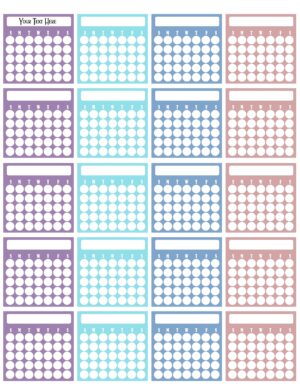
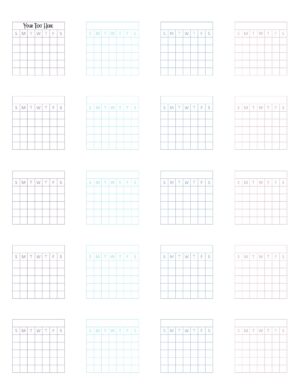
 My name is
My name is
Your website is incredible, thank you for allowing your templates to be personalized and for free. I will be coming back, but purchasing and not just free downloads.
Blessings,
Becky
Bless your heart for allowing people to access your templates. I was pulling my hair out trying to figure out how to make a tracker and came across your page .. you are a blessing!